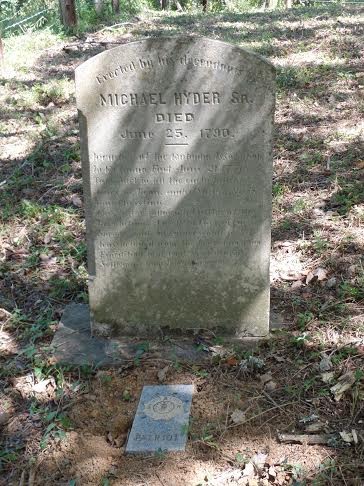Michael HYDER/HIDER Sr
The following information was assembled from numerous sources and cannot be used directly as proof of Qualifying Service or Lineage.
It is considered a research aid and is intended to assist in locating sources that can be used as proof.
Birth: 1740 / / VA
Death: 25 Jun 1790 / Washington / TN
Qualifying Service Description:
Member of Watauga Association, signer of Watauga Petition of 1776
Additional References:
- SAUNDERS, COL RECS OF NC, Volume 10, pg 708-711
- Carter County Tennessee and its People 1796 - 1993, Carter County History Commitee, Walsworth Publishing 1993, pg 185
Spouse: Elizabeth Woods
Children: John; Michael Jr; Mary Polly Elizabeth; Adam; Martha; Lydia; Jacob; Joseph; Benjamin; Katherine; Johnathan; James; Nancy; Sarah;
| Date Approved | Society | ACN | SAR Member Info | Lineage via Child | View Application Detail | |
|---|---|---|---|---|---|---|
| 1985-08-05 | OK | 229611 | James Philip Anthony (126169) | Mary/Polly | ||
| 1993-01-26 | TX | 211691 | Damon Paul Smith (140129) | Michael | ||
| 1995-07-12 | NC | 205524 | Charles Curtis Griggs (144857) | Mary/Polly | ||
| 2004-07-29 | TN | 20077 | Charles Ray Williams (163084) | Mary/Polly | ||
| 2004-07-29 | TN | 20078 | Charles Ronald Williams (163085) | Mary/Polly | ||
| 2004-07-29 | TN | 20079 | Terrance Jerome Williams (163086) | Mary/Polly | ||
| 2004-07-29 | TN | 20080 | Gregory Todd Williams (163087) | Mary/Polly | ||
| 2004-08-05 | TN | 20311 | Jimmy Ray Williams (163112) | Mary/Polly | ||
| 2006-10-04 | TN | 26469 | William Glen Campbell (167965) | Mary/Polly | ||
| 2010-03-30 | LA | 38324 | Seth Andrew Webber (176553) | Jacob | ||
| 2010-03-30 | LA | 38325 | Robert Wayne Webber (176554) | Jacob | ||
| 2010-07-08 | NC | 39583 | Christopher Lee Hall (177471) | Mary/Polly | ||
| 2010-07-13 | KS | 39318 | James David Riddell (164571) | Mary/Polly | ||
| 2013-06-25 | KS | 53729 | William Preston Lehman (187708) | Jacob | ||
| 2014-03-19 | NC | 57658 | Matthew Perry Crabtree (190407) | Jonathan | ||
| 2014-04-16 | LA | 58299 | Richard Alexander Corbett Jr. (190744) | Michael | ||
| 2017-05-04 | TN | 74513 | Raymond Gregory Best (202552) | Mary/Polly | ||
| 2024-12-31 | TN | 114728 | Frank Christopher McKenzie (232233) | Mary/Polly | ||
| 2025-05-02 | FL | 116264 | John Michael Giles (233459) | Mary |
Comments:
- Upright Stone & Granite in-ground SAR marker
- Photo by permission: James Ervin McKinney, Tennessee Society SAR
Directions to Cemetery / Gravesite:
- Cemetery is located on top of a hill off Lonesome Dove Lane in Elizabethton, TN
- From Johnson City take US 321 toward Elizabethton. At the first traffic light, turn left on to Miligan Highway. At the first traffic, light turn left on to Powder Branch Rd. In 0.9 mi., a small road bears off to the left, this is Lonesome Dove Lane. As soon as you turn left, there is a gate on the left that will take you into a field. Follow the trail/road in the field to the top of the hill and the Hyder Cemetery is on the left
Additional Information:
In the History Book Carter County Tennessee and its People 1796-1993 p185, Michael Hyder Sr is described as one of the early pioneer families of what was then Washington District NC which became Carter County TN in 1796. Within this paragraph it is stated that he was a member of the Watauga Association and was one of many signers of the Halifax / Watauga Petition of 1776. It also states that he was with John Sevier in almost all his expeditions against the indians and british, including the battles of Musgrove Mill, Thickety Fort and Cedar Springs. He had volunteered to fight at Kings Mountian, however Sevier had asked him, James Allen Edens Sr, and John Carter to stay behind and guard Fort Watauga against indian attack. Another noteworthy service is that Michael Hyder developed one of the first blackpowder manufacturing mills in the Powder Branch area and that powder from Hyder's mill was used at the Battle of Kings Mountian South Carolina
